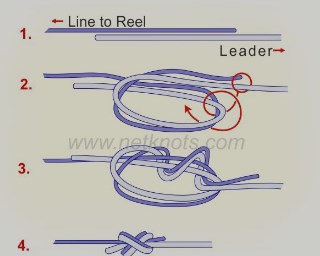Clinch Knot in Fly Fishing
Introduction
As an avid fly fisher, one of the first skills I mastered was tying the clinch knot. Its reliability and simplicity make it a staple in any angler’s repertoire. In this guide, I’ll share insights and tips on how to tie the clinch knot effectively, along with its practical applications and advantages.
Introduction to the Clinch Knot

The clinch knot is more than just a knot; it’s a symbol of reliability and strength in the world of fly fishing. Whether you’re a novice angler or a seasoned pro, mastering the clinch knot is essential for success on the water. Let’s dive into the intricacies of this versatile knot and explore how it can enhance your fly fishing experience.
Understanding the Anatomy of the Clinch Knot
Tying the clinch knot is a simple yet precise process. Start by passing the tag end of your leader through the eye of the hook, creating a loop. Then, wrap the tag end around the standing line multiple times before threading it back through the loop. Finally, moisten the knot and tighten it securely against the hook eye. This knot is renowned for its strength and reliability, making it an ideal choice for securing flies and lures.
Advantages of the Clinch Knot
What sets the clinch knot apart from other knots is its sheer reliability. Once properly tied, the clinch knot forms a tight and secure bond that can withstand the toughest of fights. Its simplicity makes it a favorite among anglers of all skill levels, providing peace of mind knowing that your fly or lure is securely attached.
When to Use the Clinch Knot

The versatility of the clinch knot makes it suitable for a wide range of fishing scenarios. Whether you’re casting dry flies on a tranquil stream or battling trophy trout in fast-flowing rivers, the clinch knot performs admirably. Its ease of tying and strong hold make it a go-to choice for anglers in various conditions and fishing techniques.
Mastering the Technique
Tying the clinch knot may seem daunting at first, but with practice and patience, it becomes second nature. Pay close attention to each step of the tying process, ensuring that the wraps are snug and evenly spaced. Avoid over-tightening the knot, as this may weaken its integrity. With practice, you’ll soon be tying clinch knots with confidence and precision.
Practical Applications
From delicate presentations to aggressive retrieves, the clinch knot adapts to the demands of fly fishing with ease. Use it to secure a dry fly for selective trout or attach a streamer for predatory bass. Experiment with different variations of the clinch knot to suit your fishing style and preferences. With the clinch knot in your arsenal, you’ll approach each cast with confidence and anticipation.
Alternative Knot Options

While the clinch knot reigns supreme in many fishing scenarios, it’s essential to explore alternative knot options to expand your skill set. Experiment with knots like the improved clinch knot or the palomar knot to see how they compare in terms of strength and ease of tying. Having a repertoire of knots at your disposal ensures adaptability in any fishing situation.
Tips for Knot Maintenance
To ensure the longevity and reliability of your knots, regular maintenance is essential. Inspect your knots before each fishing outing, checking for signs of wear or slippage. Retie knots that show any signs of weakness or damage, and consider replacing worn leaders or tippet material. By staying proactive with knot maintenance, you’ll minimize the risk of losing that prized catch due to a faulty knot.
Safety Considerations
In the world of fly fishing, safety should always be a top priority. The integrity of your knots directly impacts the success of your angling endeavors, so take the time to tie them correctly. Test each knot thoroughly before casting, ensuring that it holds under pressure. Remember, a well-tied clinch knot could be the difference between landing a trophy fish and experiencing heartbreak on the water.
Incorporating the Clinch Knot into Your Fishing Arsenal

As you continue your fly fishing journey, the clinch knot will become an invaluable tool in your arsenal. Practice tying it regularly to maintain proficiency, and don’t hesitate to experiment with variations and adaptations. Whether you’re chasing trout in mountain streams or targeting bass in expansive lakes, the clinch knot will be there to secure your connection to the fish of a lifetime.
Community and Resources
Fly fishing is as much about camaraderie as it is about catching fish. Connect with fellow anglers to share tips, stories, and experiences. Online forums, local clubs, and fishing communities provide invaluable resources for learning and growth. Attend workshops and events to expand your knowledge and skill set, and don’t be afraid to seek guidance from more experienced anglers.
Clinch Knot Success Stories
Every angler has a story about the clinch knot saving the day. Whether it’s landing a trophy trout or battling a feisty bass, the reliability of the clinch knot has been proven time and time again. Share your success stories with fellow anglers to inspire and motivate others to master this essential knot.
Embracing the Learning Process

Fly fishing is a journey of continual learning and discovery. Embrace the challenges and setbacks along the way, knowing that each experience brings you one step closer to mastery. Be patient with yourself as you hone your knot tying skills, and celebrate every success, no matter how small. With dedication and perseverance, you’ll unlock the full potential of the clinch knot and elevate your fly fishing game to new heights.
Conclusion
The clinch knot stands as a testament to the timeless artistry of fly fishing. Its simplicity belies its strength and reliability, making it an indispensable tool for anglers of all skill levels. By mastering the clinch knot and incorporating it into your fishing repertoire, you’ll embark on a journey of endless possibilities and unforgettable experiences on the water.
FAQs:
Is the clinch knot suitable for all types of fishing lines?
Yes, the clinch knot works well with monofilament, fluorocarbon, and braided fishing lines. It provides a secure connection regardless of the line type.
2. How many wraps should I make when tying the clinch knot?
Generally, making 4-6 wraps around the standing line is sufficient for most fishing scenarios. However, you can adjust the number of wraps based on the diameter and strength of the line you’re using.
3. Can the clinch knot slip or come undone during a fight with a fish?
While no knot is entirely foolproof, the clinch knot is known for its reliability and strength. When tied correctly and tested before casting, it should hold securely even during intense battles with fish.
4. Is the clinch knot difficult to tie for beginners?
The clinch knot is relatively easy to learn and master, making it suitable for anglers of all skill levels. With practice and patience, beginners can tie the clinch knot confidently and efficiently.
5. Are there any situations where I should avoid using the clinch knot?
While the clinch knot is versatile and reliable in many fishing scenarios, there may be situations where alternative knots are more suitable. For example, when using very heavy or slick lines, a stronger knot like the palomar knot may be preferred.




